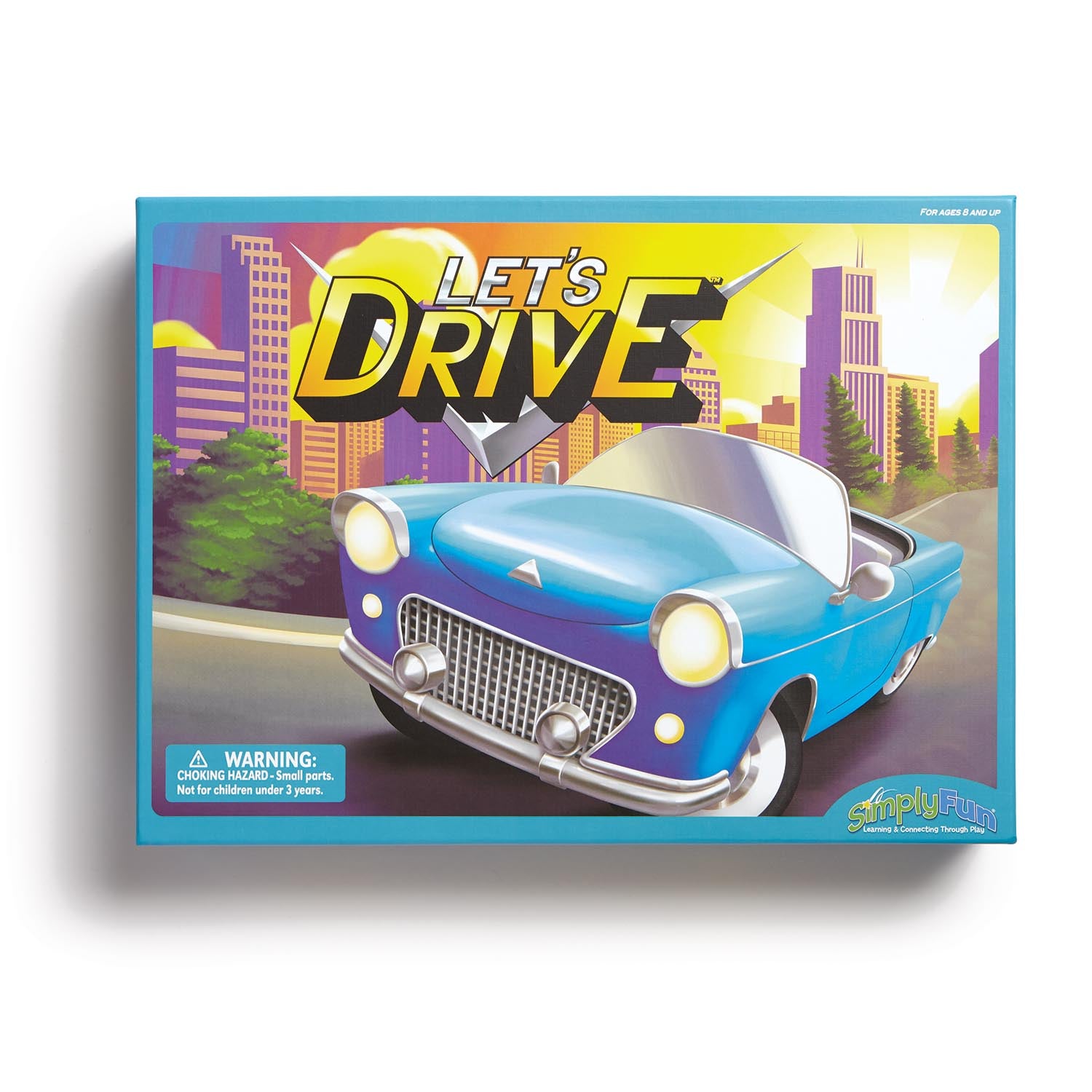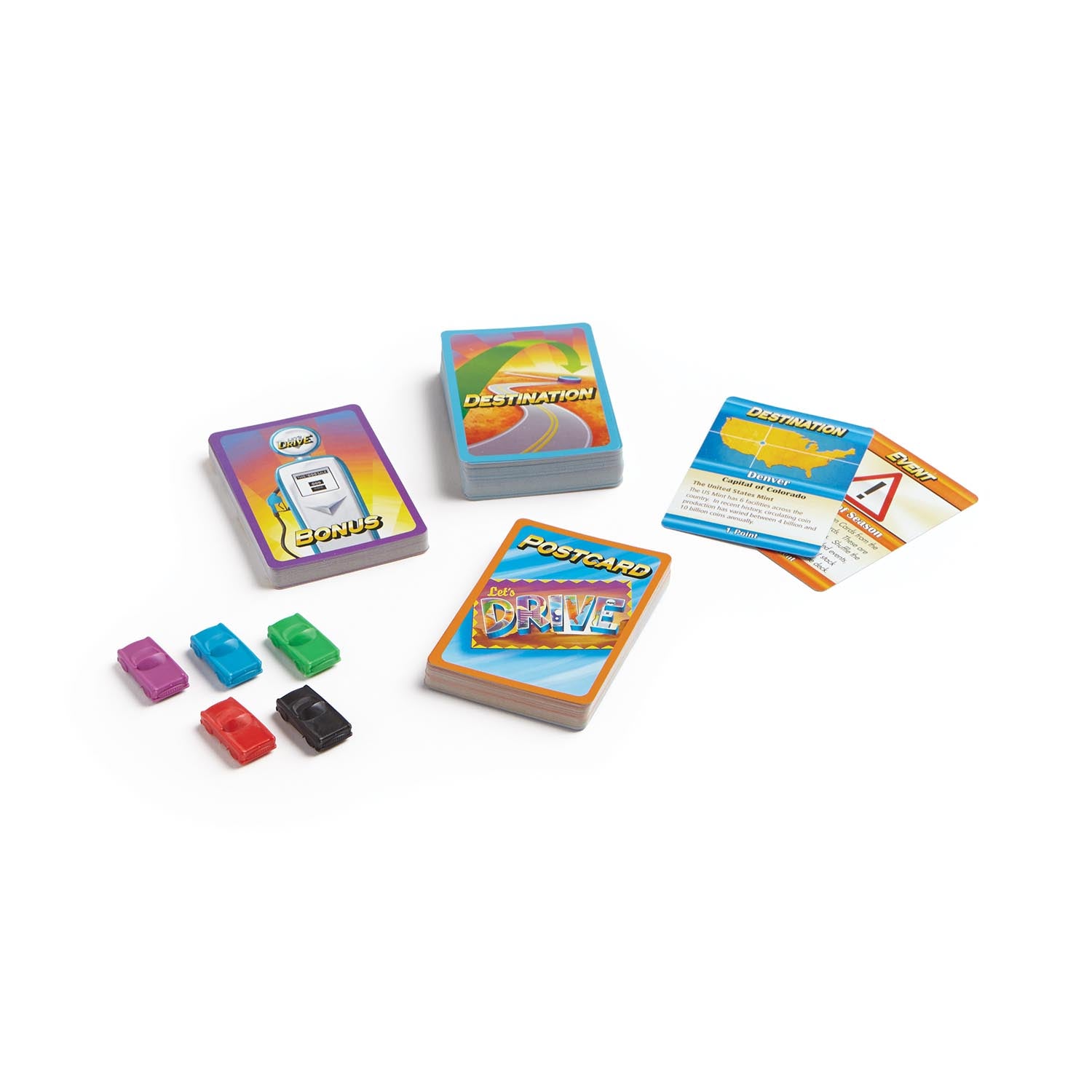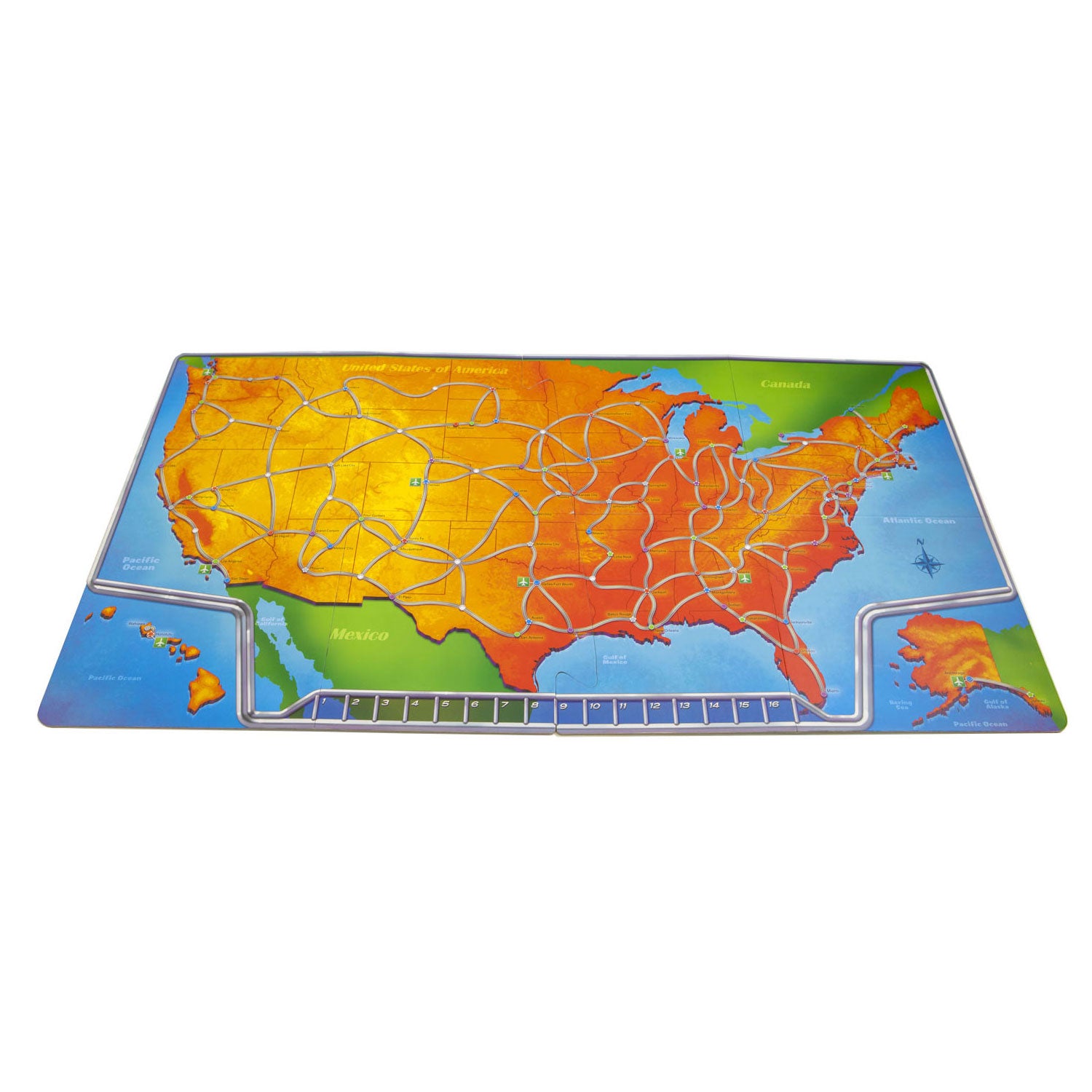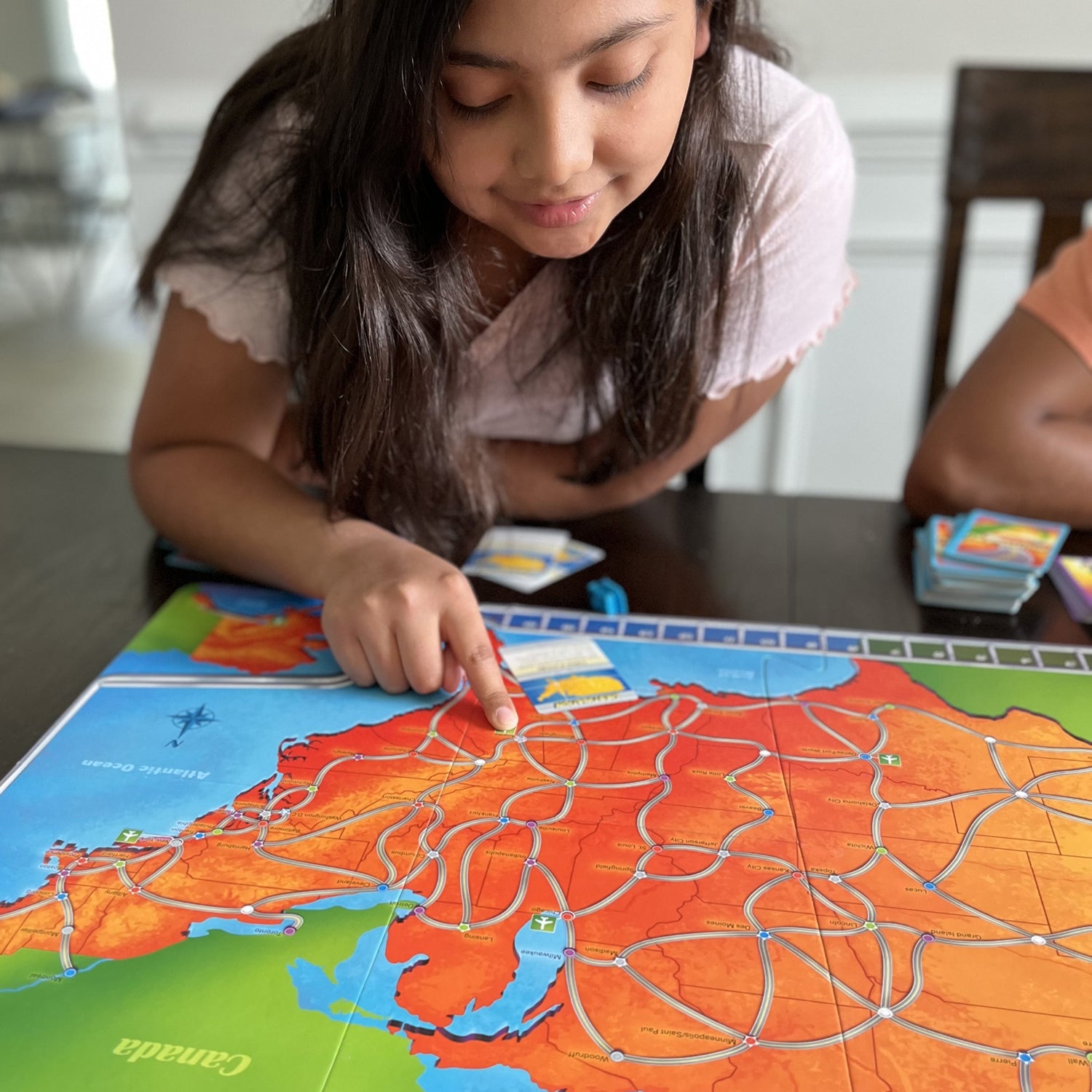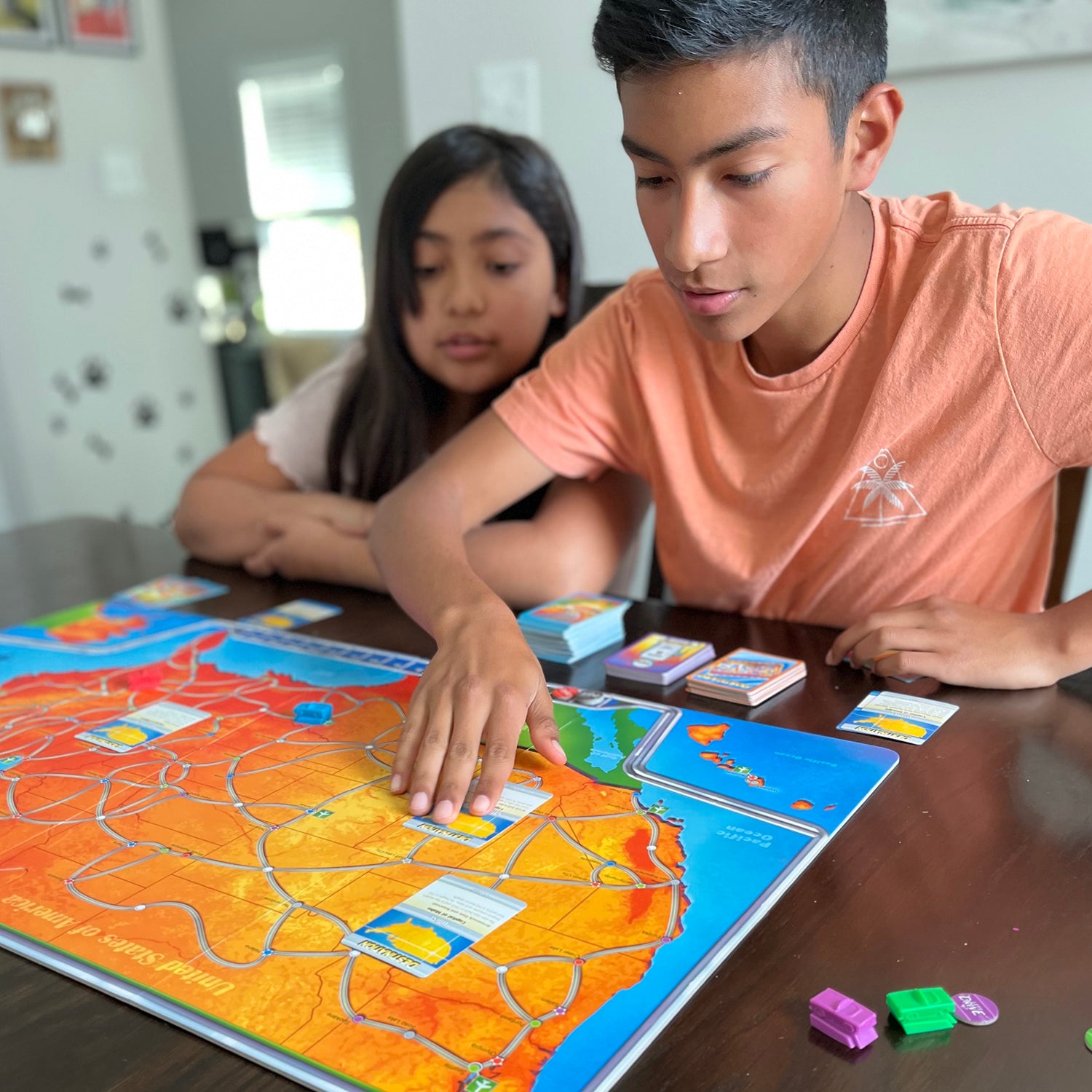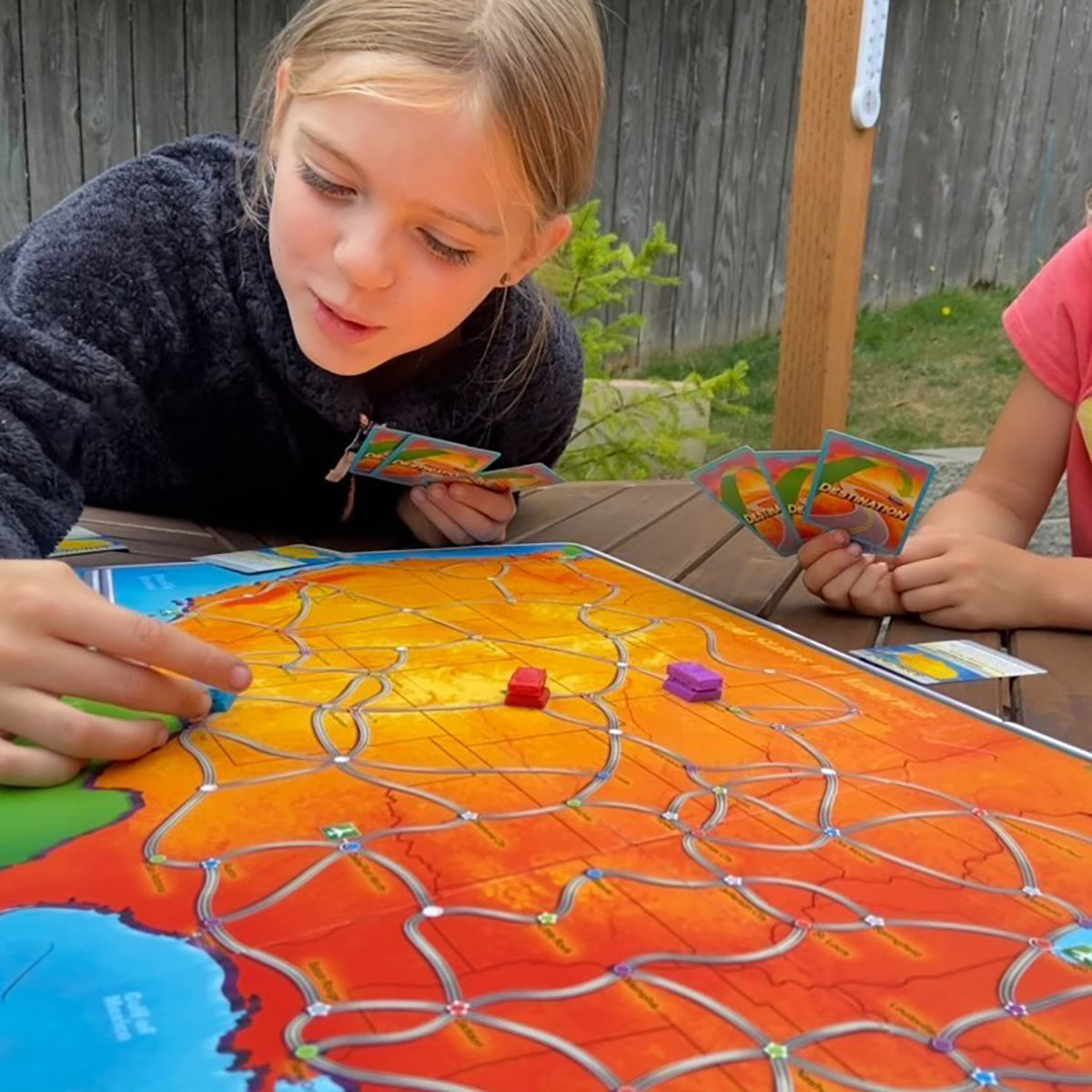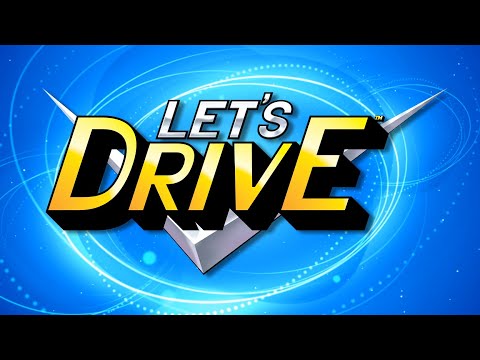Let's Drive
Let's Drive
2-5 players • 30 min • 8 & up
Focus: Geography
Couldn't load pickup availability
Learn locations of the states, state capitals and scenic locations as you drive through the United States.
Skills: Geography, State Facts & Information
Game Includes
Game Includes
- 100 Destination Cards
- 30 Postcard Cards
- 26 Bonus Cards
- 16 Event Cards
- 5 Car Pawns
- 5 Scoring Chips
- 1 Game Board (2 pieces)
- 1 U.S. Fact Sheet
- 1 Rules Booklet
Share
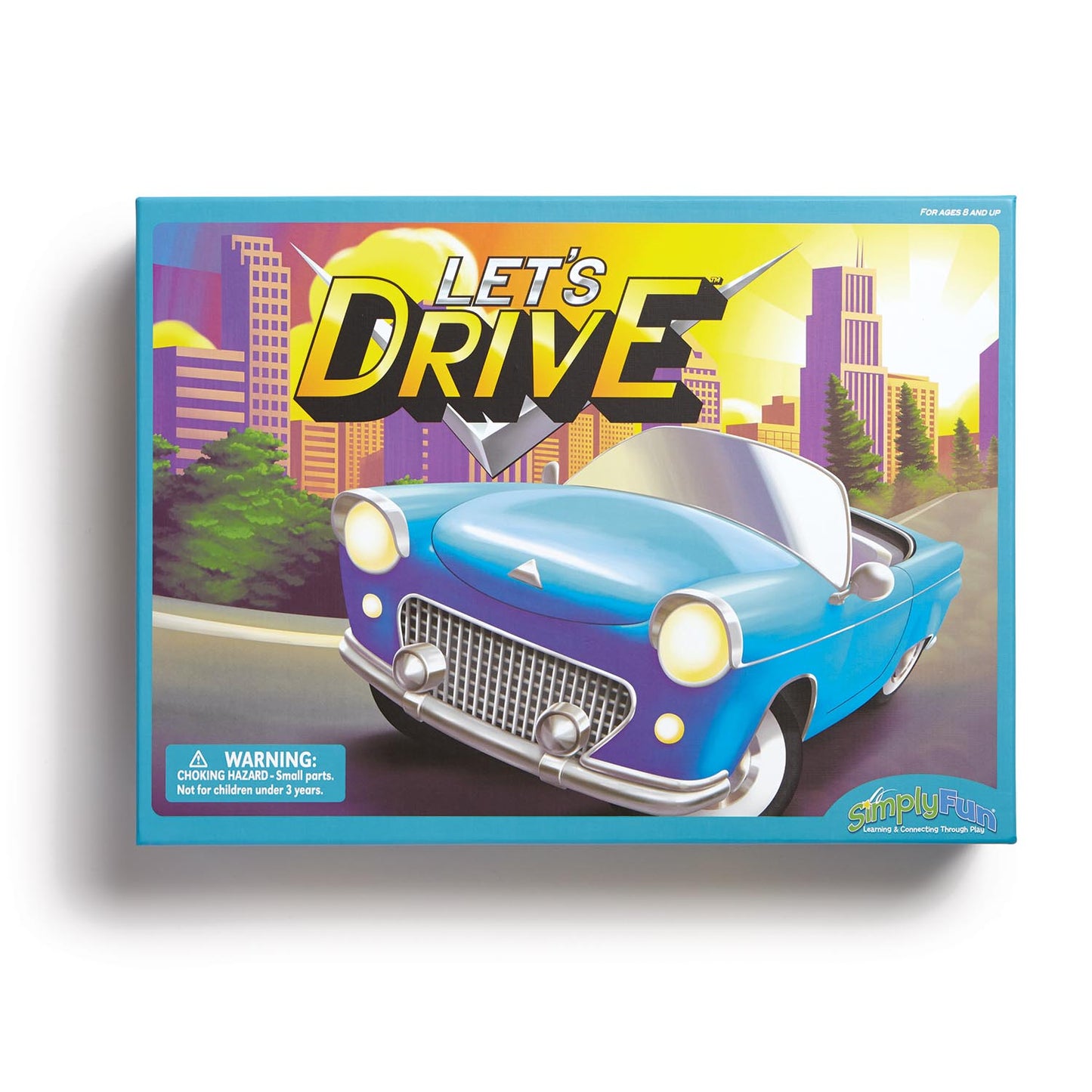
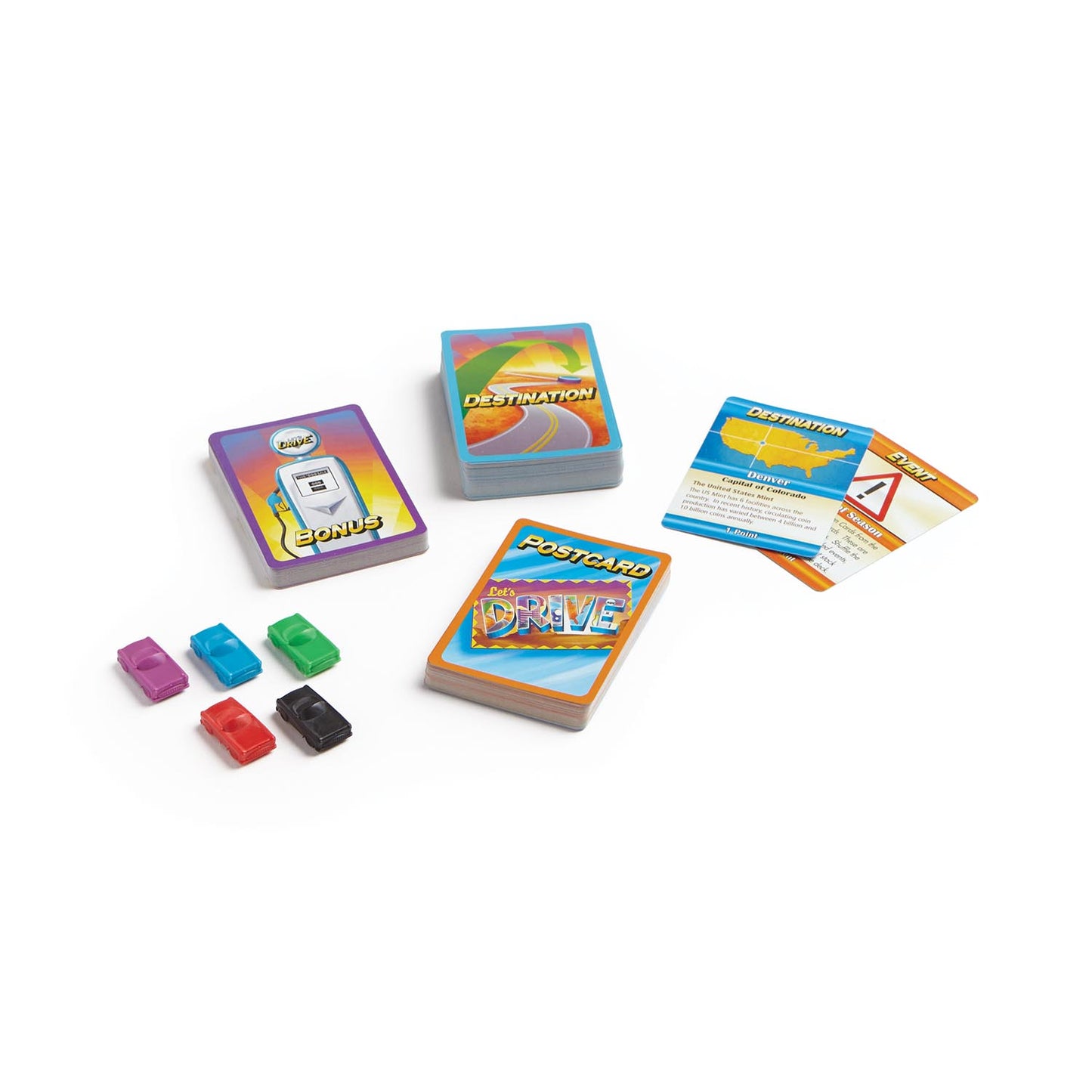
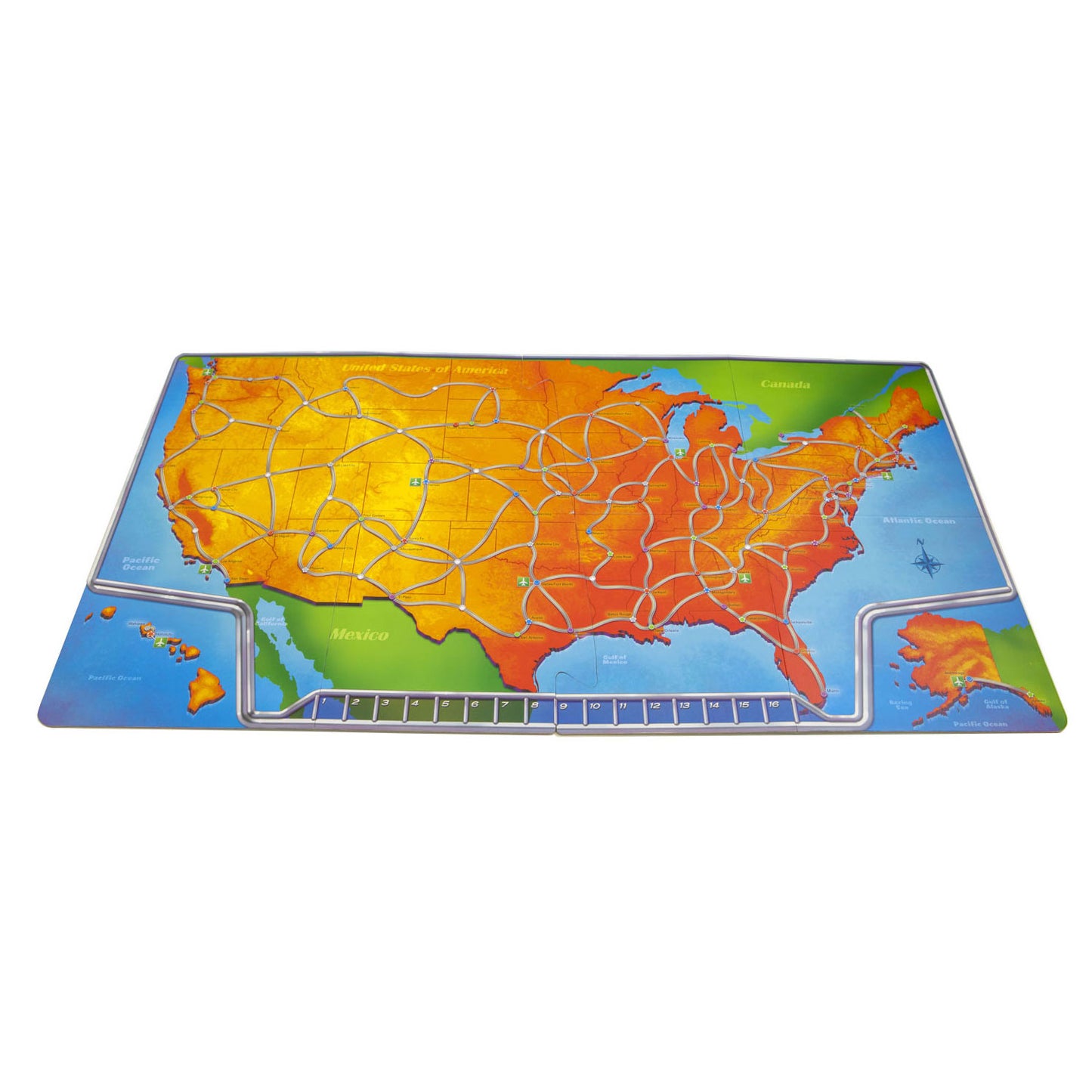
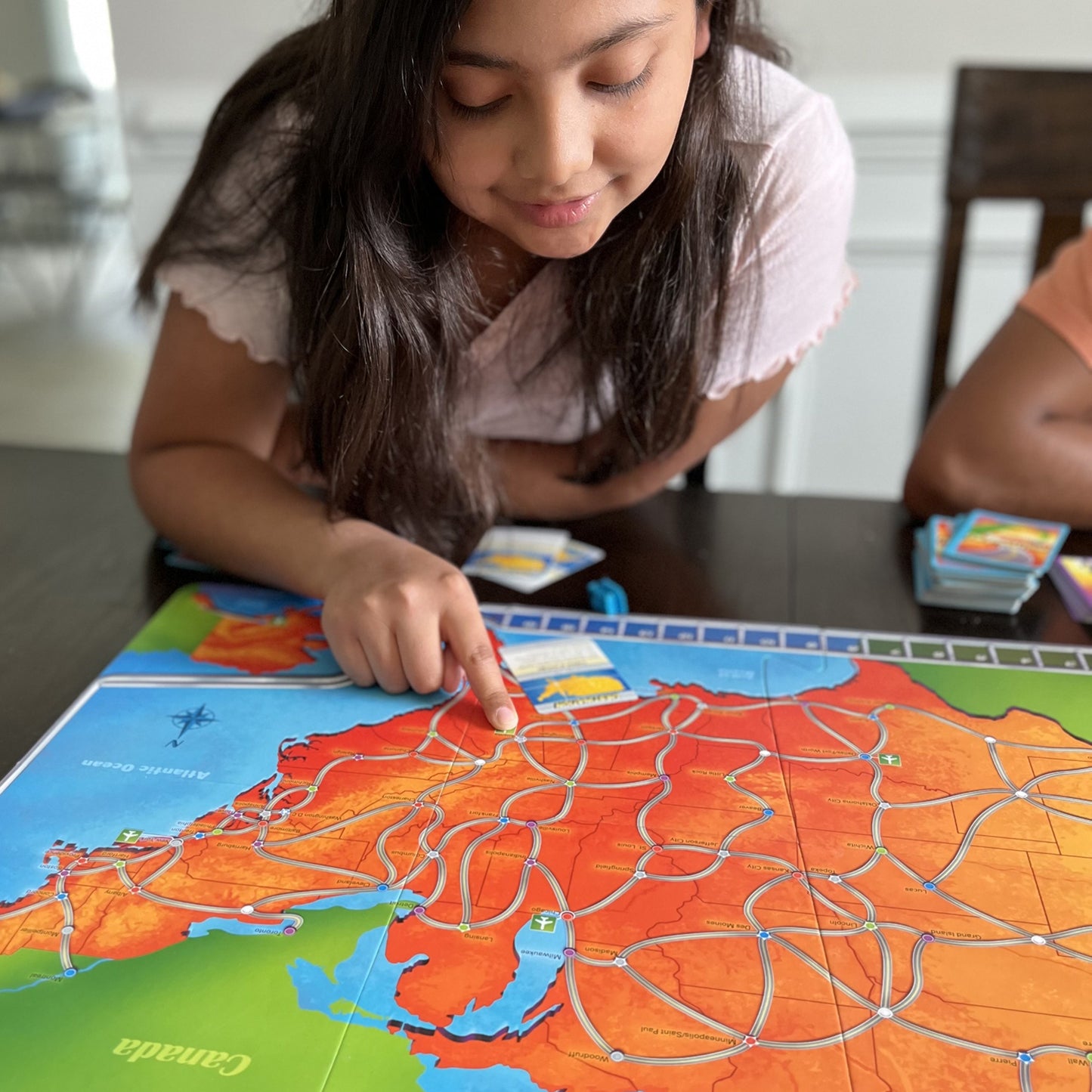
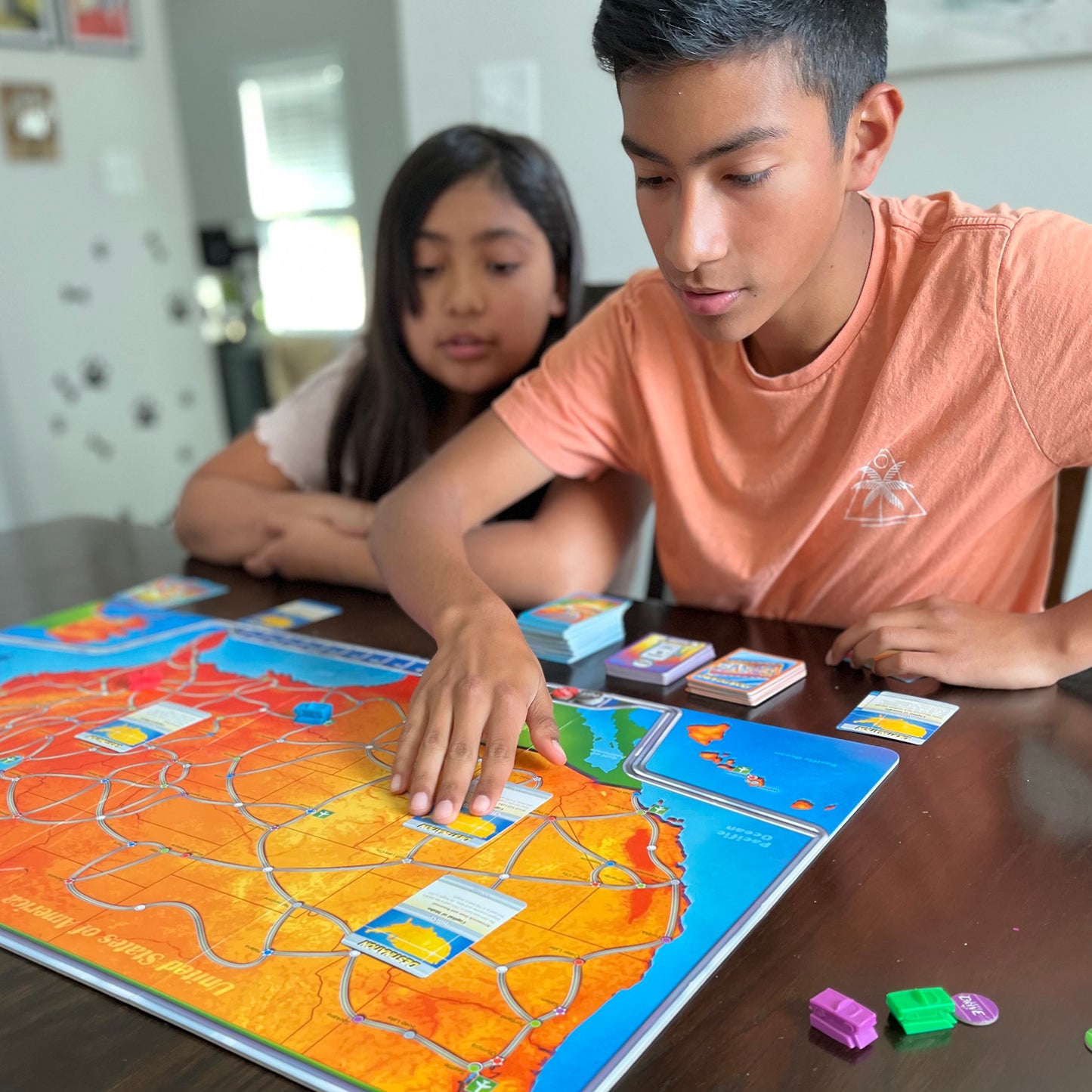
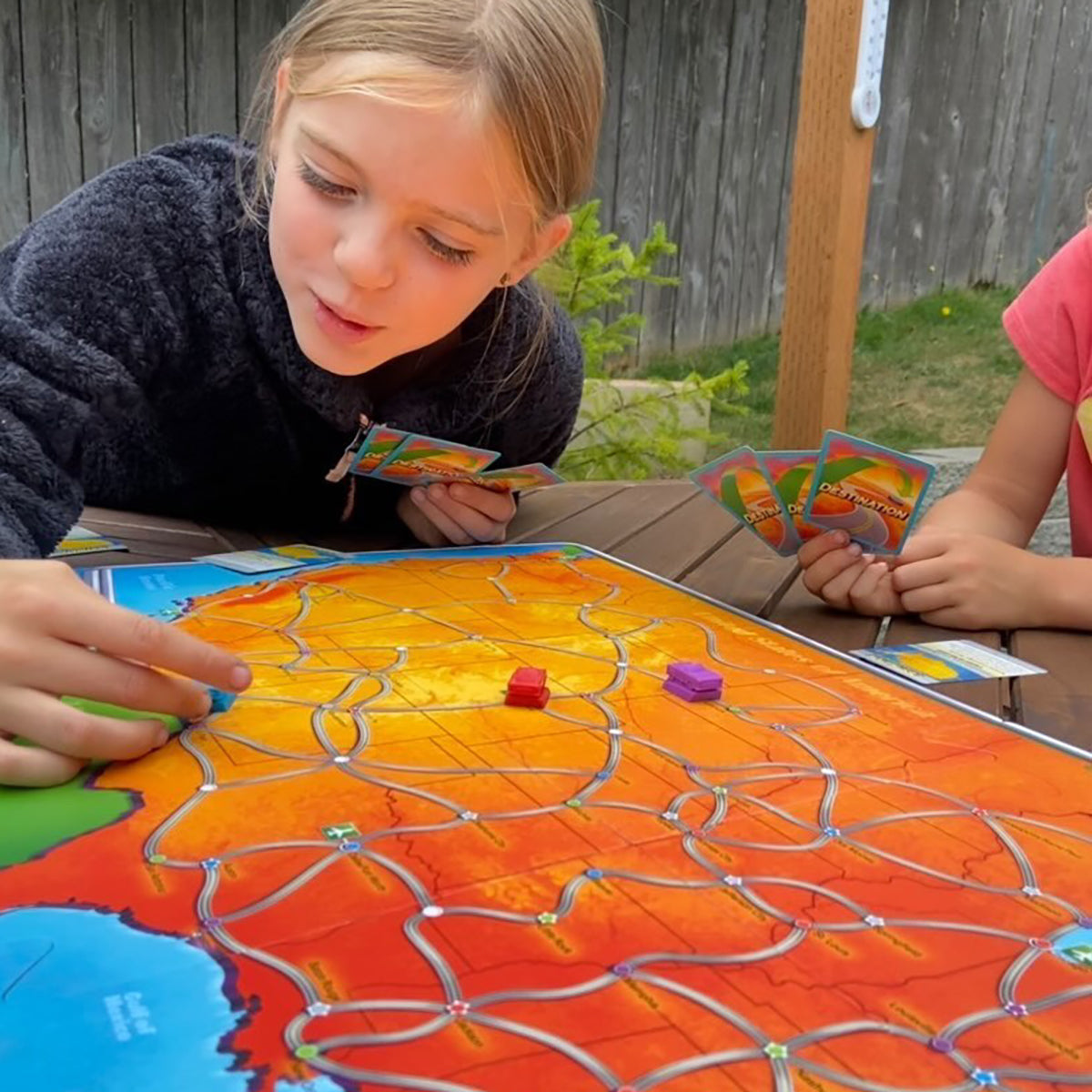


Collapsible content
How to Play
Educational Standards
Core Standard*: Language, Social Studies
Language
- Reading
- Informational Text
- Range of Reading & Level of Text Complexity. Grade Levels 3rd
- Integration of Knowledge and Ideas. Grade Levels 3rd
- Speaking and Listening
- Comprehension & Collaboration. Grade Levels 3rd
- Language
- Vocabulary Acquisition and Use. Grade Levels 3rd
Math
- Mathematical Practice
- Make sense of problems and persevere in solving them. Grade Levels 3rd, 4th
History/Social Studies
- Geography
- Understands and applies basic mapping elements such as symbols, compass rose, labels and a key to reading and construct maps that display information about neighborhoods or local communities. Grade Levels 2nd
- Understands and applies how maps and globes are used to display the regions of North America, in the past and the present. Grade Levels 3rd
- Understands the physical, political and cultural characteristics of places, regions and people in North America, including the locations of the Fifty States within the regions of the U.S. Grade Levels 3rd
Skills
Explore
What Does Child Do To Use Skill In The Game?
Players can explore the game board, the facts on the extra fact sheet, and the game cards to learn new facts about the cities and states in the game.
How Parents Can Assist Learning
It is easy for children to ignore the factual aspects of the game, so parents play an important role in ensuring that the facts are read and enjoyed. Let children read the facts for each city they arrive at, or parents can read the facts if needed.
Learning Implications and Educator Support
It is easy for children to ignore the factual aspects of the game, so educators play an important role in ensuring that the facts are read and enjoyed. Let children explore the board before playing to discuss where they have been or may want to go because they have heard about it.
Determine
What Does Child Do To Use Skill In The Game?
Players need to determine where cities are located, how best to get there, and how many moves it will take.
How Parents Can Assist Learning
Parents can encourage children to look at their options, consider airports, and so on.
Learning Implications and Educator Support
Educators can encourage children to look at their options, consider airports, and so on.
Compare
What Does Child Do To Use Skill In The Game?
Players compare locations, relative distance, and facts about cities (if they read the cards) as they move around the board.
How Parents Can Assist Learning
Parents ask questions to encourage comparison. How many moves are there between each city? How far apart are their different destinations? Which cities have airports?
Learning Implications and Educator Support
Educators encourage children to think about different routes. Point out options the child may not have considered, like going to an airport and flying to the nearest city. Ask questions to encourage comparison. How many moves are there between each city? How far apart are their different destinations? Which cities have airports? Children also make choices by comparing other players destinations and likelihood of reaching them.
Remember
What Does Child Do To Use Skill In The Game?
Players need to remember to send postcards when appropriate.
How Parents Can Assist Learning
Children may have visited some of the cities. Parents can encourage discussion of what the children remember about the cities. They can also contribute their own memories to trigger the child's memories. "Remember when we went on the boat to the Statue of Liberty?"
Learning Implications and Educator Support
Children may have visited some of the cities. Educators can ask children what cities they have been to and what they remember about the cities. Also ask how they got to each city and how far it seemed to them. During the game encourage children to remember successful strategies.
Predict
What Does Child Do To Use Skill In The Game?
Players can relate what they learned on previous turns to think about next move. Did it help to fly to the airport? Should I get to the cities in one area first?
How Parents Can Assist Learning
Parents can help children think about outcomes for different possible moves. Which cities are likely to result in quicker or more options for connection to other cities?
Learning Implications and Educator Support
Educators can help children think about outcomes for different possible moves. Which cities are likely to result in quicker or more options for connection to other cities?
Plan
What Does Child Do To Use Skill In The Game?
Players make moves based on their hypothesis about what is the fastest way to get a city card.
How Parents Can Assist Learning
Parents can model their planning by talking about how they are thinking about which city and route to take. This requires parents to be noncompetitive! Remember for these educational games, part of the intent is to help your child learn strategies!
Learning Implications and Educator Support
Educators can encourage children to count out the alternative paths to make the best decision they can. This also supports regulating impulsivity. Also encourage children to watch how other players plan their approach to their cities and how they use the various options in the game.
Experiment
What Does Child Do To Use Skill In The Game?
Players analyze different paths to see which will result in fewer moves.
How Parents Can Assist Learning
Parents can encourage players to move their cars along different paths prior to making a final choice of which path to take. This allows the children to have physical as well as mental representations of their options. In this way they can compare options.
Learning Implications and Educator Support
Educators can encourage children to move their cars along different paths prior to making final choice of which path to take. This allows the children to have physical as well as mental representations of their options. In this way they can compare options.
Practice
What Does Child Do To Use Skill In The Game?
With each turn players practice a strategy. They will learn which result is a greater number.
How Parents Can Assist Learning
Parents can encourage players to move their cars along different paths prior to making a final choice of which path to take. This allows the children to have physical as well as mental representations of their options. In this way they can compare options. In addition, with each new destination, children will practice and learn from different options.
Learning Implications and Educator Support
Educators can encourage players to move their cars along different paths prior to making a final choice of which path to take. This allows the children to have physical as well as mental representations of their options. In this way they can compare options. When children demonstrate good strategies, encourage them use them again.
Solve
What Does Child Do To Use Skill In The Game?
Successful strategic approach results in players capturing destination cards and gaining points.
How Parents Can Assist Learning
Parents can offer suggestions in non-controlling ways. For example, "I wonder what would happen if you did…." This will enable the children to think about another strategy, but make a decision on their own. They can also keep a running commentary on what they are doing in their own turn. This will enable children to hear another perspective on how to solve the problem of getting to a destination.
Learning Implications and Educator Support
Educators can encourage children to use a strategy on certain bonus cards. Once children start using a successful strategy, comment on what they are doing. They need to know they have a good strategy. If children's strategies are not successful, encourage taking a different perspective by saying, "I wonder what would happen if you did…." This will enable them to think about another strategy, but make a decision on their own.
Review
What Does Child Do To Use Skill In The Game?
Players may review if encouraged. See Implications for Learning and Adult Support.
How Parents Can Assist Learning
After a player reaches a destination, ask if s/he thinks their's was the best approach. Was there another way that would have been better? At the end of the game, the parent can review the destination cards used in the game to see if any of the players remember any city facts.
Learning Implications and Educator Support
After a player reaches a destination, ask if s/he thinks that was the best approach. Was there another way that would have been better? At the end of the game, the educator can review players' cards and see if any of the players remember any city facts.
Demonstrate
What Does Child Do To Use Skill In The Game?
Participants are demonstrating their preferences or ideas by answering the questions.
How Parents Can Assist Learning
If appropriate, encourage children to make drawings, collages, charts or other visual representations of what they have discussed. For example, make a drawing of the most beautiful sunset they can imagine in response to the question, "Do you prefer sunrises or sunsets?"
Learning Implications and Educator Support
If appropriate, work with children to make drawings, collages, charts or other visual representations of what they have discussed. For example, make a drawing of the most beautiful sunset they can imagine in response to the question, "Do you prefer sunrises or sunsets?"
*Data compiled from CCSSI ELA Standards, WA Science Standards, and Washington Social Studies Standards
Special Needs
Cognitive
Suggestions for How to Modify Play Experience
This variation simplifies the play for children with cognitive delays. Place five destination cards on the board. Place a token on each of the cities chosen, so children can clearly see their targets. Children then try to get as many of the five cards as they can. One option is to let the player to the left of a given player choose the location of the starting point for the given player. This way each person is choosing a location to start, but not for themselves. Use only Destination Cards.
Children can play the game as described in the directions, accept they do not hold cards in their hands. The three destination cards are placed on the board, and when one is reached, the player who got there keeps the card. Another card is then drawn and placed on the board. The winner is the first one to get 10 destination cards. This simplifies the game and makes it a little shorter for those who have a short attention span.
When a destination is reached, read the card to all the players. When the game is finished, each player needs to recall a fact about one of their cities to tell the others.
Communication
Suggestions for How to Modify Play Experience
When a destination is reached, read the card to all the players. When the game is finished, each player needs to recall a fact about one of their cities to tell the others.
After the game ask questions about whose city was the furthest away, who used the most airports, etc. Adults can also prompt children to discuss different trips or visits to locations that other players may have made.
Sensorimotor
Suggestions for How to Modify Play Experience
Children play the game as described in the directions, accept they do not hold cards in their hands. The three destination cards are placed on the board, and when one is reached, the player who got there keeps the card. Another card is then drawn and placed on the board. The winner is the first one to get 10 destination cards. This simplifies the game and makes it a little shorter for those who have a short attention span.
Social Emotional/Behavioral
Suggestions for How to Modify Play Experience
Play the game with a partner. For each turn the pair discusses options and reaches consensus about which way to go.
Vision
Suggestions for How to Modify Play Experience
Not recommended for visually impaired.
Hearing
Suggestions for How to Modify Play Experience
No modifications required
*Data compiled from CCSSI ELA Standards, WA Science Standards, and Washington Social Studies Standards
Autism
Autism Strengths & Interests
Short Summary of Strengths & Interests
- Has good spatial reasoning skills.
- Has ability to read city names and short sentences.
- Enjoys geography or maps.
Is good at matching visual items
Is This Game Appropriate? Yes
Description
Players need to match the written destinations (ex: Chicago) on their cards to the same written destinations on the map. Children who like finding word matches will like this aspect of the game.
Has a good memory for sensory details, including visual, touch, taste and smell
This game is not appropriate
Has a good memory for words, phrases and dialouge
Is This Game Appropriate? Yes
Description
Children need to remember the destination cards in their hands so they recognize when another player goes past one of their destinations, which gains the player an extra point. If remembering the locations in their hand is too challenging, have all players announce the cities they are going through as they move their cars.
This game is not appropriate
Likes to put things in order or a sequence
Is This Game Appropriate? Yes
Description
A key aspect of Let's Drive is determining a path or sequence for moving a player's car token. Players try to create the shortest path they can to get to the desired destination. Looking at different path options may appeal to children who are good at making sequences or enjoy playing with maps.
Learns through visualizing or "replaying" actions in their mind
Is This Game Appropriate? Yes
Description
Let's Drive is a good game for children who are good at visualizing options. In particular, players are at an advantage if they can recall strategies and moves they have made or have seen other players use. The ability to replay and analyze moves teaches children what is likely to be successful on future moves.
Likes activities with rules, such as math and phonics
This game is not appropriate
Is very concrete and literal
This game is not appropriate
Learns in small "chunks" (for example, phone numbers are 3 chunks of number xxx-xxx-xxxx that are combined together)
This game is not appropriate
Is good at nonverbal reasoning and logic
Is This Game Appropriate? Yes
Description
The game involves nonverbal reasoning about methods of travel, distance, and order or sequence of movement. Children may also like the ability to move their car as a part of their reasoning. However, they do not need to talk about their logic or strategy.
Likes spatial problem solving
Is This Game Appropriate? Yes
Description
Spatial reasoning is the basis for Let's Drive. Children with good spatial reasoning skills will hone them as they pick the best sequence and the best routes for reaching multiple destinations.
Can read well with good vocabulary, though may not fully comprehend content
Is This Game Appropriate? Yes
Description
For children who can read with comprehension, Let's Drive is a good game for demonstrating and strengthening that skill. Children need to read their destination cards and can learn facts about their locations by reading the short descriptions provided.
Likes to use and has good fine motor skill
Is This Game Appropriate? Yes
Description
Some children enjoy games like checkers or chess partly because they get to move pieces around a board. Similarly, Let's Drive involves moving car tokens around the board in small and large jumps towards desired destinations.
Likes established routines or set ways of doing things
This game is not appropriate
Likes manipulating, constructing or building things
This game is not appropriate
Likes to use and has good musical abilities
This game is not appropriate
Likes to use and has good drawing skills
This game is not appropriate
Autism Special Considerations
Appears to ignore other's communication and/or has difficulty giving eye contact to a communication partner
Is This Game Appropriate for Child with Characteristic? Yes
Can Child with Characteristic Play Game w/o Modification? No
Strategies for Developing Compensatory Skills:
Look at the game instead of each other.
Person talking holds the object being talked about near their mouth to bring the child's attention to the object. This also shows the child how the words about the object are produced. For example, hold the Destination Card up and say, "Honolulu."
Rather than speak, sing communication between turns or when giving short directions. Music attracts the child's attention and interest.
Use unusual or exaggerated inflection to begin a communication about the game. This attracts the child's attention.
Has difficulty understanding complex verbal directions
Is This Game Appropriate for Child with Characteristic? Yes
Can Child with Characteristic Play Game w/o Modification? No
Strategies for Developing Compensatory Skills:
Break down directions into small steps. Don't go through all the directions at once.
Combine short verbal instructions with visual and physical examples of each step. For example, demonstrate using the road then demonstrate flying, so children can see the potential consequences.
Check for comprehension by asking the child to show you what to do next. For example, ask the child to send you a postcard and see how the child responds.
Let children read the directions as they are explained. Visualizing the words is often a stronger learning method for children with autism.
Uses vocabulary inaccurately or demonstrates echolalia (repeating another's speech)
Is This Game Appropriate for Child with Characteristic? Yes
Can Child with Characteristic Play Game w/o Modification? No
Strategies for Developing Compensatory Skills:
Respond to immediate echolalia (repeating what was just said) by rephrasing the child's response into a correct format, so the child can hear and repeat that phrase. For example, assume you are playing with a child named Andy and you say, "Your turn," and Andy repeats, "Your turn." You can say, "It's Andy's turn. You say, my turn." This allows the child to hear and repeat the correct response. Eventually, the child will pick up the pattern of response.
Delayed echolalia (repetition of previously heard comments) may have a hidden meaning or association. Look for connection in the phrase used to the current situation. For example, the child says, "After these messages we'll be right back!" Think what the repeated phrase is associated with for the child. Try to interpret what is meant and rephrase it for the child. For example, you might respond by saying, "It sounds like you want a break for a few minutes. Is that what you mean? You can tell me, 'I need a break.'"
Gets stuck repeating a verbal topic or physical actions and/or has difficulty attending to others' actions or topic.
Is This Game Appropriate for Child with Characteristic? Yes
Can Child with Characteristic Play Game w/o Modification? Yes
Strategies for Developing Compensatory Skills:
Incorporate a preferred topic into the game to increase motivation. For example, if the child is fixated on a particular character, like a favorite super hero, ask what the character would do if they were playing? For example, place an action figure of the favorite superhero on the child's starting city and say, "You need to get [favorite superhero] to Detroit!!"
Practice phrases for commenting on others' play actions. For example, you say to Joe (who is playing with you), Joe drove when he could have flown." Then ask the child, "What do you think about that? "
Remind children about listening and watching others' before making their own comment or action.
Use a motivation toy or object to gain the child's attention. For example, a preferred wind-up toy can be placed on the board when it is the child's turn. The child gets to wind up the toy after completing their turn.
Use the child's finger to point to what needs attention. He will attend to his finger first, and then the adult can point out the object he is pointing at. For example, use the child's finger to trace the route and count the stops.
Extend the child's action to make a correct response. For example, if the child moves only one stop, say, "Keep going."
Reinforce attention and actions by commenting on what was done correctly. For example, "I love that you told me what your options were. That way I know what you are thinking about."
Has difficulty producing speech/communication
Is This Game Appropriate for Child with Characteristic? Yes
Can Child with Characteristic Play Game w/o Modification? No
Strategies for Developing Compensatory Skills:
Use augmentative communication, such as picture cards. For example, a picture of person pointing to another person means "your turn."
Use gestures and sign language to illustrate actions or concepts. For example, use the sign for 'finished' (two hands facing down, spread out from the middle of the body), point to the next player and say, "I'm done. It's your turn." The signs and gestures add a visual component to support understanding.
Extend the child's sounds into words or words into phrases to provide a model. For example, if the child says, "New York, the adult says, "You are driving to New York."
Provide at least 10 seconds wait time for the child to process or produce responses. It may take longer to formulate a thought or response for children with special needs.
Has difficulty sequencing multi-step actions and/or doing complex abstract tasks
Is This Game Appropriate for Child with Characteristic? Yes
Can Child with Characteristic Play Game w/o Modification? No
Strategies for Developing Compensatory Skills:
Use physical actions to walk through steps numerous times, with less support for the final step each time. This is called "shaping." For example, walk through the steps of drawing a card, looking at options, and moving a token, Then do the first two steps and say, "What do you do next?"
Ask children to identify each destination card they have, then ask them to compare the number of stops to each. Ask which has the fewest stops.
Demonstrates difficulty initiating and maintaining social interactions
Is This Game Appropriate for Child with Characteristic? Yes
Can Child with Characteristic Play Game w/o Modification? Yes
Strategies for Developing Compensatory Skills:
Develop a social story to be read at the start of a game. A social story is a short booklet that illustrates how a child can use positive social skills. It includes two to five descriptive statements and a directive statement. For example: "When I watch others, I will know when it is my turn. Others like me when I take turns. I will watch what others do with their pieces and listen to what they say. Others like it when I talk about the game." Add photos or drawings of the child doing the actions described in the story.
Role play social situations and reinforce appropriate words and actions. For example, role play finishing the game and congratulating the winner. Or, role play commenting on another player's turn. For instance, model for the child asking, "Did you like what I did?"
Use video feedback of positive social behaviors. Video of actual play enables children to see what they or others did. Appropriate actions and interactions can then be discussed.
Acts out or demonstrates avoidance behaviors when frustrated, overwhelmed, or needs more sensory input.
Is This Game Appropriate for Child with Characteristic? Yes
Can Child with Characteristic Play Game w/o Modification? No
Strategies for Developing Compensatory Skills:
Reduce extraneous noise or allow the child to wear head phones or ear plugs if loud sounds cause anxiety.
A weighted vest worn during the game may provide additional pressure input and thus reduce fidgeting due to sensory needs. Pressure can be calming when used for no more than 20 minutes at a time.
Practice a phrase to ask for help and role play situations in the game where it is needed.
Provide techniques for self-calming, such as holding a special toy.
Allow time for movement. For example, a child who needs to move frequently can be given an opportunity to 'celebrate' their turn by running around the table or jumping up and down 10 times.
Has short attention span for non-preferred activities
Is This Game Appropriate for Child with Characteristic? Yes
Can Child with Characteristic Play Game w/o Modification? No
Strategies for Developing Compensatory Skills:
Provide a break when needed.
Use "when...then" phrases. For example, "When you take your turn, then I'll let you play with your toy."
Frequently remind the child of the goal of the game. "Don't forget you need 16 points to win."
Incorporate a motivating activity as part of the play. For example, each player gets to manipulate a fun 'fidget' toy, such as a stress ball or squeeze toy.
Needs sameness or consistent routines and/or has difficulty with transitions from one activity to another
Is This Game Appropriate for Child with Characteristic? Yes
Can Child with Characteristic Play Game w/o Modification? No
Strategies for Developing Compensatory Skills:
Play games at the same time every day, so the child anticipates the game routine.
Change the location of the game, so the child may play in different rooms, at the table, or on the floor. This will build tolerance for variation.
Prepare the child ahead time for the introduction of a new game. Talk about aspects that will be motivating for the child, and let them explore the parts of the game before setting out the whole game.
Provide a structure for placement of game pieces that can be the same each time the game is played. For example, have a specific location for where the board goes, the pieces, etc.
Provide choices for how the child can be involved in set up or clean up. For example, you might ask, "Do you want to put the public cards or the board or give each player four destinations?"
Involve the child verbally and with actions for the transition to the game table or at the end of game play. For example, you might say, "Let's look at the pictures on the game box and guess what it is about."
Use an object cue. Let the child hold an object from the game or activity you want to introduce prior to the transition. For example, if you were intending to play Let's drive, you would hand the child a car pawn from the game and say, "Look here is a car. Let's find the game it goes with?"
Has difficulty understanding others' feelings, intentions, and the reasons for others' actions.
Is This Game Appropriate for Child with Characteristic? Yes
Can Child with Characteristic Play Game w/o Modification? No
Strategies for Developing Compensatory Skills:
Model and point out what others are feeling and comment on their facial expressions or words.
Discuss what causes feelings in others. For example, "You are happy because you got a postcard. But, look at Joe's face. He is not happy because he has a long way to go!"
Ask child to explain their own feelings and intentions.
Ask child to explain why other players did specific actions in the game.
*Data compiled from CCSSI ELA Standards, WA Science Standards, and Washington Social Studies Standards
Extended Play
Extra Ways to Play the Game
Rather than move 3 spaces each turn, roll a die and move the number of spaces on the die.
Materials Needed
One die.
Developmental Benefits
Adding a die increases strategic difficulty of game by introducing unpredictability. Anticipating and predicting based on variables, rather than consistent data, is important to cognitive development.
Extra Ways to Play the Game
When player successfully obtains a Destination Card, they must read the card aloud, otherwise they don't get a point.
Materials Needed
No additonal materials needed.
Developmental Benefits
Reading aloud is valuable for learning and reinforcing essential language arts skills. Sharing content on the cards helps others learn information that relates to grade 3-4 social studies and history. Additionally, adults can engage children in conversations based on the Destination cards to share more facts about those states, road trips they took as a child, imagine what might be happening in those states at that time (ex: it is dark in NY but light in CA), etc.
Extra Ways to Play the Game
Pick any 2 destination cards and place them on the board. Put any car on one of the cards. Move the car through at least 10 states in order to reach the second card. 5 points for getting to other card in exactly 10 states. Deduct 1 point for each additional state. Before you pick up the cards, try to discover another path that goes through 10 states.
Materials Needed
No additonal materials needed.
Developmental Benefits
This game will involve trial and error strategy. It will help kids develop spatial awareness and create mental maps. By creating multiple paths to same card, children are changing perspective which is important to creative thinking. This activity can be social so that all players cooperate to reach destination in 10 states. Social play advances a wide range of social emotional skills such as active listening, collaborative decision-making and sharing.
Extra Ways to Play the Game
When player lands on a Capital, gain an extra point for saying the state motto or nickname. If player is not able to, another player will read the motto and nickname aloud for everyone to hear and try to remember for next time.
Materials Needed
No additonal materials needed.
Developmental Benefits
This helps children develop memory and to learn essential information about U.S. social studies. By reading nickname and motto aloud, one player is helping teach other players. Teaching others is important to developing mastery over subject-matters and socially connecting with peers.
*Data compiled from CCSSI ELA Standards, WA Science Standards, and Washington Social Studies Standards
Collapsible content
How to Play Video & Transcript
Let’s Drive is a set-collecting strategy game for players ages 8 and up. The oversized map easily accommodates up to 5 players, and the game plays quickly in about 30 minutes.
Inside the box, you’ll find a deck of 100 destination cards, plus smaller decks of post cards and bonus cards. You earn a bonus every time you complete a set of three destinations in the same color, and you earn a postcard if someone visits a destination you’re holding.
Each player gets to drive one of these five posh roadsters, so pick your favorite color and let’s hit the open road!
Not only is Let’s Drive an exciting strategy game, it also teaches valuable educational lessons about US geography, all of the state capitals and it demonstrates the wide variety of monuments and attractions across this diverse countryside.
The game also comes with a useful fold-out page that lists fun facts about each state’s motto, nickname and the date of its statehood. Did you know that the state motto of Montana is “Gold and Silver”?
Here’s how to play. Shuffle each of the three decks separately, and deal three Destinations directly on the map. Anyone may travel to these locations to collect these points.
Also deal each player four cards.
Each player must select one of these cities as their starting city - put their car on that city on the map, and place the card face up in front of them as their first point.
You are ready to play. The starting player is the person who has most recently been on a road trip.
On your turn, your car can move three times using roads or airlines shown on the map. Try to get closer to one of the destinations you’re secretly or be the first to claim one of the public cards.
When you reach one of your goals, take the card and put it face up in front of you. Move your colored chip ahead on the score track to show your new point total. Be sure you draw back up to a hand of three cards refill the public cards.
If needed, you may travel between any two cities which have airports - but if you do, you must end your turn in the second city (even if you have moved less than 3 times).
Pay attention on other players’ turns. If someone travels to a city you’re holding, give them your card to score, and take one of the postcards to give yourself a point as well.
Note that destinations and postcards come in five different colors. Try to score a set of three cards of the same color to earn a card from the Bonus deck. Bonus cards are revealed immediately and often score additional points or offer you a special new ability.
The game is over immediately when a player’s score reaches 16 or more points.
Let’s Drive is another thrilling geography game from your friends at SimplyFun. It’s great fun for the whole family, and one that repeatedly gets requested on our own game nights. What will these guys think of next?
- Choosing a selection results in a full page refresh.
- Opens in a new window.

